As more and more companies embrace remote work, it’s important to have a solid strategy in place to ensure success. Companies that embrace remote work can enjoy several benefits, such as increased productivity, reduced overhead costs, and access to a larger talent pool. However, managing a remote workforce requires a different approach than managing an on-site team. From communication tools to performance metrics, this guide covers the seven essential elements of a successful remote workforce strategy. Whether you’re a manager or an employee, these tips can help you thrive in a remote work environment. In this article, we will discuss seven essential elements of remote workforce strategies.
Communication
Effective communication is crucial for any remote team. Since remote employees don’t have face-to-face interactions with their colleagues, managers must make sure that communication is clear and consistent. This includes using the right tools and technologies, setting expectations, and providing feedback. One of the most important elements of a successful remote workforce strategy is having clear communication and collaboration tools in place. This includes video conferencing software, instant messaging platforms, and project management tools. It’s important to choose tools that are user-friendly and accessible to all team members, regardless of their location or technical abilities.
Regular check-ins and team meetings can also help ensure that everyone is on the same page and working towards the same goals. This can help to ensure that tasks are completed on time and that everyone is aware of any changes or updates. Regular check-ins and team meetings also provide an opportunity for team members to discuss any issues they may be having, as well as brainstorm ideas and solutions.
Collaboration
Collaboration is essential for remote teams to work effectively together. Managers need to create a culture of collaboration that encourages employees to work together and share their ideas. This can be achieved through regular team meetings, brainstorming sessions, and other collaborative activities. Collaboration is an essential element of remote workforce strategies as it promotes teamwork and a shared sense of purpose among remote employees. In a remote work environment, it is easy for employees to feel isolated and disconnected from their colleagues. However, by encouraging collaboration, managers can foster a culture of mutual support and collaboration that helps remote employees feel more connected to their team members.
Collaboration also allows remote workers to share their ideas and expertise, leading to improved problem-solving and innovation. Through regular team meetings, brainstorming sessions, and other collaborative activities, managers can create a collaborative culture that helps remote teams work together effectively and achieve their goals.
Productivity
Remote employees often work independently, which can lead to productivity issues. Managers need to establish clear goals and expectations for their remote team members and provide the necessary resources to help them achieve those goals. This includes setting up a clear work schedule, providing the right tools and software, and offering support and feedback. Productivity is a critical element of remote workforce strategies, as it directly impacts the success of a remote team.
Remote workers may face unique distractions and challenges that can affect their ability to stay focused and complete tasks efficiently. Therefore, managers must establish clear expectations and provide the necessary resources to help remote employees maintain their productivity levels. This includes setting up a clear work schedule, providing the right tools and software, offering support and feedback, and implementing performance metrics to track progress. By prioritizing productivity as an essential element of their remote workforce strategy, companies can ensure that their remote team members are contributing to the overall success of the organization.
Technology
Technology is essential for remote work. Managers must ensure that their remote team members have access to the right tools and software to perform their jobs effectively. This includes providing remote access to company systems, offering video conferencing software, and using cloud-based project management tools. With remote work becoming more prevalent, cybersecurity and data protection measures are more important than ever. Remote employees may be accessing sensitive company information from their personal devices or using unsecured networks, which can put company data at risk. Implementing strong cybersecurity measures, such as two-factor authentication and virtual private networks (VPNs), can help protect against data breaches and cyber-attacks. It’s also important to educate remote employees on best practices for data protection, such as using strong passwords and avoiding phishing scams.
Additionally, employers should provide remote employees with access to secure networks and data storage solutions. Employers should also ensure that remote employees are aware of the company’s security policies and procedures, such as how to report a security breach or suspicious activity. Finally, employers should provide regular training on cybersecurity topics to keep remote employees up-to-date on the latest threats and best practices for staying safe.
Training and Development
Remote employees require training and development just like on-site employees. Managers must provide their remote team members with the necessary resources to develop their skills and grow professionally. This includes offering online training, providing coaching and feedback, and providing opportunities for career advancement. Just because employees are working remotely doesn’t mean they shouldn’t be held accountable for their performance. In fact, setting clear goals and expectations is even more important in a remote work environment.
Managers should establish regular check-ins with remote employees to discuss progress toward goals and provide feedback. It’s also important to use performance metrics to track progress and identify areas for improvement. By setting clear goals and providing regular feedback, remote employees can stay motivated and engaged, leading to better overall performance. Goals should be specific, measurable, achievable, relevant, and time-bound (SMART). Feedback should be timely and constructive, focusing on what the employee is doing well and areas for improvement. Additionally, managers should provide regular check-ins to ensure employees are staying on track with their goals and to provide support when needed.
Culture and Engagement
Maintaining a positive company culture is essential for remote teams. Managers must create a culture of engagement that makes remote employees feel like they are part of the team. This includes setting up regular team meetings, creating opportunities for social interaction, and recognizing and rewarding remote employees for their contributions. Culture and engagement is a critical element of remote workforce strategies because it can impact employee motivation, job satisfaction, and retention. When working remotely, employees can feel disconnected from their colleagues and company culture, which can lead to feelings of isolation and disengagement.
To combat this, managers must create a culture of engagement that fosters a sense of community and belong for their remote team members. This can include regular team meetings, virtual social events, and recognition and rewards for remote employees’ contributions. By prioritizing culture and engagement in remote workforce strategies, managers can build a strong and cohesive team that feels valued, connected, and motivated to achieve success.
Work-Life Balance
Remote employees often struggle to maintain a work-life balance. Managers must encourage their remote team members to take breaks, set boundaries between work and personal time, and prioritize their well-being. This includes offering flexible schedules, providing mental health resources, and encouraging employees to take time off when needed. Another essential element of a successful remote workforce strategy is implementing flexible work schedules and effective time management practices. This includes setting clear expectations for work hours and availability, as well as providing resources and support for time management and productivity.
Encouraging breaks and time off can also help prevent burnout and promote work-life balance for remote employees. It’s important to find a balance between flexibility and structure to ensure that work is completed efficiently and effectively. Flexibility allows employees to work in a way that best suits their individual needs and preferences, while structure provides a framework for tasks to be completed on time and with quality. Having both flexibility and structure in place can help create an environment where employees feel supported and empowered to do their best work.
Conclusion
In conclusion, remote work has become an undeniable aspect of modern business, and it requires a unique approach to management. With the help of BorderlessHR, your company can successfully implement remote work strategies and achieve maximum productivity and engagement from your remote workforce. By focusing on the seven essential elements of remote workforce strategies, our team can help you create a culture of collaboration and success that benefits both your employees and your company. Don’t let the challenges of remote work hold you back – partner with BorderlessHR today and unlock the full potential of your remote workforce.







